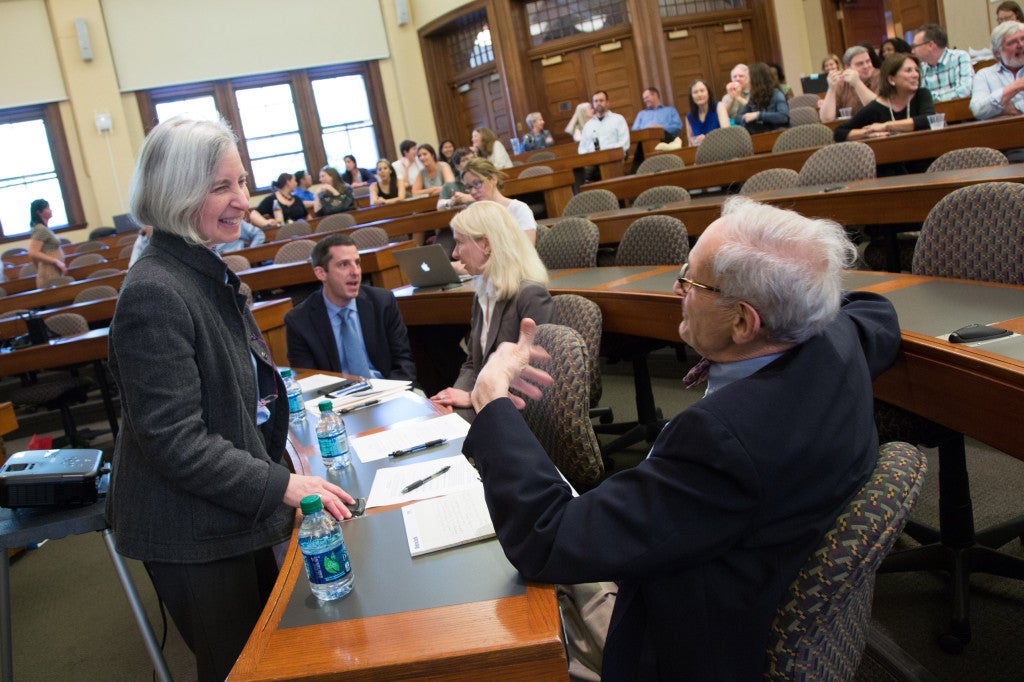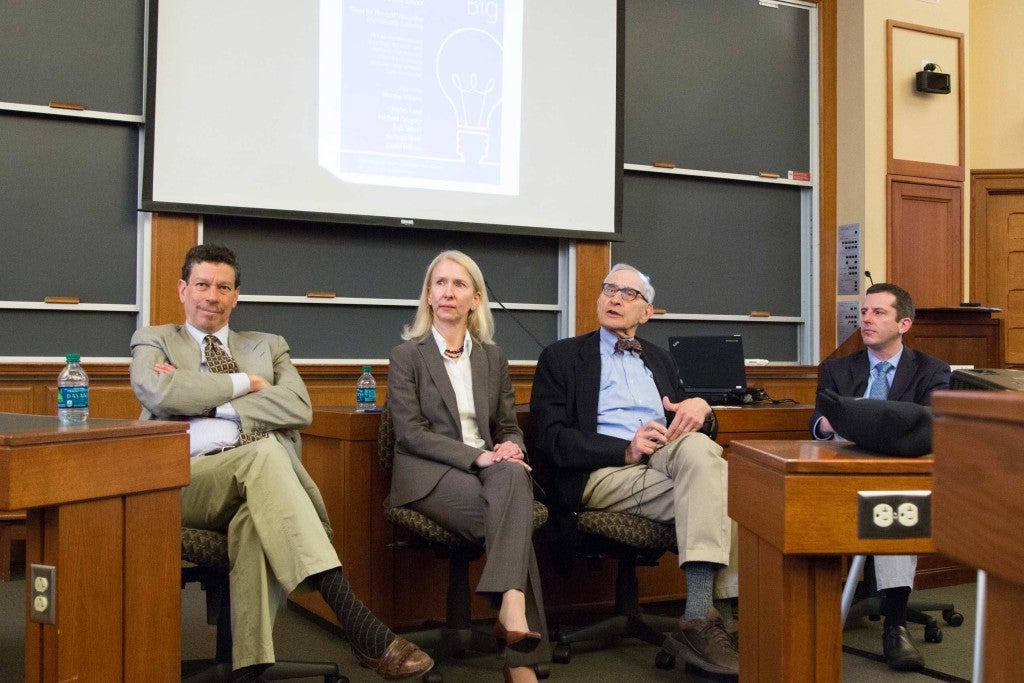
In late May, four Harvard Law faculty members, Charles Fried, Michael Gregory, Kathryn Spier and David Wilkins, each shared a snapshot of innovative research with the HLS community, followed by discussion as part of the 2015 Harvard Law School Thinks Big lecture.
HLS Dean Martha Minow called it one of the great events of Harvard Law School. It marks our commitment to being a community of learning and acknowledges, she said, “that the very best ideas come when many minds work together.”
Charles Fried, the Beneficial Professor of Law, talked about the results of U.S. Supreme Court decisions under Chief Justices Burger and Rehnquist when a compromise was reached on issues such as abortion, affirmative action and campaign finance. These decisions, he said, knitted together incompatible views and theories, “but it sort of worked.” But ever since, advocates on both sides of these decisions have been pushing and the result he said, under the Roberts Court has been “the unraveling.” Fried focused in his talk on campaign finance and a series of Supreme Court decisions that have gradually undone limits put in place. The compromise he said, was a nice idea, but it put together two things that don’t quite go together, “regulated elections and a free-for-all.”
David Wilkins ’81, the Lester Kissel Professor of Law and vice dean for global initiatives on the legal profession, spoke about why disruptive innovation is coming to the legal services profession and what it means for Harvard Law School. Applying the concept developed by Harvard Business School Professor Clayton Christensen, Wilkins described disruptive innovation as a situation where there is new competition, and the establishment ignores it and then the competition moves its way up the market, and eventually their technology becomes the standard.
Wilkins, faculty director of the Center on the Legal Profession, which researches changes and conduct of the global legal profession, said law has been ripe for disruption, being one of the most conservative and highly self-regulated disciplines in the world, with tight rules on competition. “But all this is breaking down.”
Among the biggest category of disruptors, he said, are those who want to provide ordinary legal services to those who can’t afford them: 80 or 90 percent of the population. Others include those who want to use technology to streamline routine tasks. Others are using matching services likes ebay, putting lawyers together with people who need legal services. All of this, he said, is being driven by sophisticated consumers like general counsel who are being pushed to provide more for less.
But the disruptors haven’t figured it all out either, he said. “They are equating everything that we say about distinctiveness [of the legal profession] as protectionism. But I don’t think that’s true actually. Lawyers are not like taxi cabs, which can be displaced by Uber drivers.”
Part of what HLS has to do, he concluded, is to teach our students how to unbundle complex legal problems. And the really hard part will be putting it all together again. “How do we do this while preserving our core values?” he asked. “We are going to have to work together across divides, including with the disruptors.”
Kathryn Spier, the Domenico de Sole Professor of Law is an economist whose research includes assessing how to analyze the legal system. She focused her talk on current research on trends in civil litigation.
The traditional theory of settlement, she said, is that that plaintiffs either settle or go to trial, but she’s found that is much too simple. There are all sorts of possibilities. “They can tailor their lawsuit around their own tolerance for risk and their own beliefs.”
In her scholarship, grounded in theory but also in her work with data sets, she has been focused on instances in which parties in lawsuits “contract around the law.” Before the trial, they might agree that whatever its outcome, the plaintiff will receive a minimum amount from the defendant, but there also might be a cap on that amount: a high/low agreement.

Spier said she finds these contracts fascinating. Plaintiffs and defendants can tailor lawsuits to suit their own tolerance for risk and their own beliefs. Putting these contracts in bigger framework, she said, it’s as if the plaintiff is playing the role of an insurance company. And the defendant is paying an insurance premium and receiving a reduced risk of exposure, with the contract stipulating by what percentage that rate of risk will be reduced. Spier said one could also think of the defendant playing the role of a litigation funder, paying a flat amount of money for an equity stake in the outcome of the plaintiff’s claim. In these arrangements, she added, the plaintiff and the defendant have much more information than an outside investor ever could and they benefit without the costs of going to an external equity market.
This raises questions about whether these contracts should be regulated or limited. Parties to lawsuits clearly want to engage in these contracts, she said. On the other hand, these agreements may stimulate more litigation, which is risky and costly for the parties themselves and imposes costs on others such as taxpayers.
Michael Gregory ‘04, clinical professor of law at HLS, teaches and practices law as part of the Trauma and Learning Policy Initiative, a multidisciplinary partnership between HLS and Massachusetts Advocates for Children. The mission is to ensure that children who have been traumatized by their exposure to violence succeed in school. Gregory along with HLS Lecturer on Law Susan Cole, the founding director of the project, have pioneered an approach that combines advocacy, education, and advising schools.
Gregory described the facets of their approach. Though the Education Law Clinic, HLS students represent individual families with children in the special education system, most often, he said “children have had a traumatic experience that interfaces with their disability.”
The non-lawyers on the team work directly with schools, drawing on ideas TLPI developed in the two volumes of their book: “Helping Traumatized Children Learn” to aid educators figure out how they can help create “safe and supportive school learning environments as a foundation to support the learning of all students, including those who have been impacted by trauma.”
Gregory said they use everything that they learn from families and educators to advocate for policy solutions that address the needs of both groups. They have involved students in these efforts. Last summer this culminated in passage of the Safe and Supportive Schools Act, signed into law in August by then Gov. Deval Patrick ‘82, legislation for which they and HLS students had been zealously advocating.
Among other accomplishments, the legislation, said, Gregory, conveys the message that “you can make creating a safe and supportive school environment just as important as getting those standardized test scores up.”